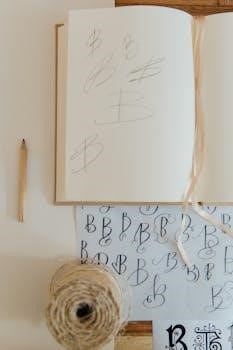
Are you ready to dive into the world of equivalent fractions? This section introduces the concept and highlights the importance of worksheets in mastering this fundamental math skill. These worksheets provide practice and reinforce understanding.

Understanding Equivalent Fractions
Let’s explore what makes fractions equivalent. This section defines equivalent fractions and explains how they represent the same value, even with different numerators and denominators. Visualization is key to grasping this concept.
Definition and Explanation
Equivalent fractions are fractions that have different numerators and denominators but represent the same proportion of a whole. For instance, 1/2 and 2/4 are equivalent because they both denote half. Understanding this equivalence is crucial for various mathematical operations, particularly when adding, subtracting, or comparing fractions.
The core principle behind equivalent fractions lies in multiplying or dividing both the numerator and denominator by the same non-zero number. This maintains the fraction’s value while altering its appearance. Worksheets often provide exercises where students must find missing numerators or denominators to create equivalent fractions.
Mastering equivalent fractions is essential for building a strong foundation in arithmetic and algebra. Recognizing and manipulating equivalent fractions allows for simplification of expressions and solving complex equations with greater ease. Practice is the key!
Visual Representation of Equivalent Fractions
Visual aids are incredibly helpful in grasping the concept of equivalent fractions. These representations often involve diagrams, such as circles or rectangles, divided into equal parts. Different fractions can then be shaded to visually demonstrate their equivalence.
For example, a circle divided into two equal parts with one part shaded (1/2) can be compared to a circle divided into four equal parts with two parts shaded (2/4). Visually, the shaded areas are identical, illustrating that the fractions are equivalent.
Worksheets frequently incorporate these visual models, challenging students to identify equivalent fractions by comparing shaded regions. Number lines also provide a linear visual, where equivalent fractions occupy the same point on the line. These visual tools enhance understanding and make learning more engaging and intuitive for students of all ages.

Methods for Finding Equivalent Fractions
Discover the methods to find equivalent fractions, including multiplication and division. These techniques allow you to manipulate fractions while preserving their value, essential for solving various mathematical problems.
Multiplication Method
The multiplication method is a straightforward approach to finding equivalent fractions. To apply this method, multiply both the numerator and the denominator of the original fraction by the same non-zero whole number. This process creates a new fraction that represents the same proportion as the original, ensuring equivalence.
For example, to find an equivalent fraction for 1/2, you could multiply both the numerator (1) and the denominator (2) by 3. This would result in the fraction 3/6, which is equivalent to 1/2. This method works because multiplying both parts of the fraction by the same number is essentially multiplying by 1, thus not changing the fraction’s value.
Worksheets often utilize this method to build a strong foundation in understanding equivalent fractions. Practice is key!
Division Method (Reducing Fractions)
The division method, also known as reducing fractions, simplifies a fraction to its simplest form while maintaining its value. This involves dividing both the numerator and the denominator by their greatest common factor (GCF). This process results in an equivalent fraction that is expressed with the smallest possible whole numbers.
For instance, consider the fraction 4/6. The GCF of 4 and 6 is 2. Dividing both the numerator and the denominator by 2 yields 2/3, which is the simplified, equivalent fraction. Reducing fractions makes them easier to understand and compare.
Worksheets provide opportunities to practice this skill, often requiring students to identify the GCF and apply the division method to various fractions; Mastering this method is essential for simplifying expressions and solving more complex math problems.
Equivalent Fractions Worksheets⁚ Types and Practice
This section explores various types of equivalent fractions worksheets designed for practice. These include finding missing numerators/denominators and identifying equivalent pairs. Regular practice enhances understanding and builds problem-solving skills.
Finding Missing Numerators or Denominators
A common type of equivalent fractions worksheet focuses on finding missing numerators or denominators. These exercises present two fractions set as equal, but one fraction has a missing value, represented by a blank or a variable. The student’s task is to determine the missing number that makes the two fractions equivalent.
To solve these problems, students need to understand the relationship between the numerator and denominator in equivalent fractions. They must identify the multiplication or division factor that links the known numerator and denominator of one fraction to the corresponding part of the other. Once this factor is found, it can be applied to find the missing value.
These worksheets often involve fractions with denominators like 2, 3, 4, 5, 6, 8, 10, 12, and 100, aligning with common core standards for grade 4. Consistent practice with these types of problems reinforces the core concept of equivalence and enhances computational skills.
Identifying Equivalent Fractions
Another key type of equivalent fractions worksheet involves identifying whether two given fractions are indeed equivalent. These worksheets present pairs of fractions, and the student must determine if they represent the same value. This can be done through various methods, reinforcing a comprehensive understanding of equivalence.
One approach is to simplify both fractions to their lowest terms. If the simplified forms are identical, then the original fractions are equivalent. Another method involves cross-multiplication. If the cross-products of the two fractions are equal, the fractions are equivalent.
Worksheets may also use visual aids, such as shaded circles or rectangles, to represent fractions. Students compare the shaded areas to determine if the fractions are equivalent. These exercises help students visualize the concept and strengthen their ability to recognize equivalent fractions in different forms.

Resources for Equivalent Fractions Worksheets
Looking for resources? Numerous websites offer equivalent fractions worksheets. These resources range from free, printable PDFs to comprehensive worksheet packs with answer keys for educators and parents alike.
Free Printable PDF Worksheets
Finding free, printable PDF worksheets for equivalent fractions is easier than you might think! Many educational websites offer a variety of worksheets that you can download and print for immediate use. These worksheets often cover a range of skills, from basic identification of equivalent fractions to finding missing numerators or denominators. They are invaluable tools for reinforcing classroom learning or providing extra practice at home. These resources are readily accessible and designed to support students in grasping this core mathematical concept. Many sites offer a diverse collection, ensuring there’s something suitable for every learning style and level. Be sure to explore the options available to find the perfect fit for your needs. Free worksheets provide an accessible route to mastering equivalent fractions.
Worksheets with Answer Keys
To enhance the learning process, seek out equivalent fractions worksheets that come with answer keys. These keys serve as a valuable tool for both students and educators, allowing for immediate feedback and self-assessment. With answer keys, students can check their work, identify mistakes, and understand the correct solutions. This promotes independent learning and helps reinforce the concepts. For teachers, answer keys save time and effort in grading, making it easier to track student progress. The availability of answer keys ensures that worksheets are not just practice exercises but also opportunities for learning and improvement. Look for resources that provide clear and accurate solutions to maximize the benefits of using equivalent fractions worksheets. This ensures effective learning.
Using Number Lines for Equivalent Fractions
Number lines provide a powerful visual tool for understanding equivalent fractions. By representing fractions on a number line, students can easily compare and identify equivalent fractions. This method helps to solidify the concept that different fractions can represent the same value. To use a number line effectively, divide it into equal segments representing the denominator of the fractions. Then, mark the position of each fraction on the line. Fractions that land on the same point are equivalent. This visual representation is particularly helpful for students in the 4th grade, where the common core standards emphasize fractions with denominators such as 2, 3, 4, 5, 6, 8, 10, 12 and 100. Using number lines makes learning fun!

Real-World Applications of Equivalent Fractions
Equivalent fractions aren’t just abstract math concepts; they’re essential in everyday life. Cooking often involves adjusting recipes, which requires understanding equivalent fractions to maintain the correct ratios of ingredients. Measuring ingredients accurately is crucial for successful baking and cooking. Construction workers use equivalent fractions when measuring materials and ensuring precise cuts. Understanding equivalent fractions is also useful in managing personal finances, such as calculating discounts or figuring out proportions when splitting bills. Even in art and design, proportions and scaling rely on equivalent fractions to maintain visual balance and harmony. By recognizing these real-world connections, students can appreciate the practical value of learning about fractions.




No comment yet, add your voice below!